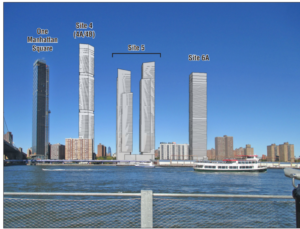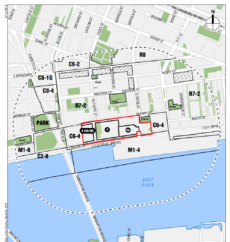
Development Rendering Image Credit: City Planning
Two Bridges development gets Appellate Division ruling but two lawsuits remain pending. On August 27, 2020, the First Department’s Appellate Division unanimously ruled in favor of a Lower East Side development that would consist of four towers, 11,000 square feet of retail, and over 2,700 residential units. Of the 2,700 residential units, approximately 700 units will be dedicated to affordable housing and 200 units will be set aside for senior housing. The project’s development group includes JDS Development Group, L+M Development Partners, CIM Group, and Starrett Development. The development’s challengers are the New York City Council and Manhattan Borough President Gale Brewer.
Development Context
The four proposed mixed use towers will stand between 63 and 80 stories tall and would be bounded by Cherry Street to the north, South Street to the south, mid-block between Clinton and Montgomery Streets to the east, and mid-block between Pike Slip and Rutgers Street to the west. Situated between the Brooklyn and Manhattan bridges, the neighborhood and project are commonly referred to as “Two Bridges” and the “Two Bridges Development.”
The area surrounding the proposed development is characterized by residential and large multifamily apartment buildings interspersed with community facilities and some retail spaces. There is a mix of tenement style walk-up buildings and some taller buildings reaching 26- and 27-stories. There are mixed income and affordable housing developments throughout the area and NYCHA public housing. The area is also known for its parks, open spaces, athletic fields and playgrounds. Generally, the City Council and Borough President bring this lawsuit because they believe the development is grossly out of scale, will have a multitude of inverse environmental impacts and should be subject to more stringent public review.
Legal Case
The legal issue in this case is whether the City Planning Commission improperly approved modifications to the Two Bridges’ Large-Scale Residential Development permit (“LSRD”). LSRDs allow greater flexibility in the planning and development of vacant land with the intention to protect and preserve scenic assets, natural features, and serve the needs of the development’s residents. The City Council and Borough President contend that the that the developers should have been required to get a special permit. That finding would have ultimately triggered the Uniform Land Use Review Procedure (“ULURP”). ULURP is the City’s framework for joint public-private consideration on major land-use changes in the city. The developers simply contend that the modification was “minor” and legally permissible under the City’s Zoning Resolution. Therefore, the developers contend that no further approvals or processes are required to undergo construction.
Site History
In understanding the decision and the legally technical issue, the development site’s history is particularly relevant. The site has been subject multiple designations and special permitting dating back to the early 1960s. In 1972, the area was first designated a LSRD as part of a federally subsidized public housing project. The special permit allowed “the location of buildings without regard for the height and setback regulations which would otherwise apply.” Two additional special permits were issued in 1977 and in 1995 a special permit was issued to another of the development’s parcels. The special permits permitted zoning actions such as height and setback variations, modified spacing requirements and that the development conform to all application parts of the Zoning Resolution. The 1995 Special Permit included a site plan for the whole LSRD and showed the empty lots where the four towers in question are proposed to be built.

Image Credit: City Planning
In 2016, the developers submitted three applications to City Planning for “minor” modifications to the special permits that would effectively facilitate the construction of the four new towers. While the applications seemingly result in substantial increases in height, bulk, and density, the developers were not required to seek a new special permit. Instead, the City Planning Commission determined that the proposed modifications were minor and not subject to ULURP. The developers were still subject to the State Environmental Quality Review Act and the City Environmental Quality Review, which the City Planning Commission ultimately approved. The modifications were approved in 2018 and the City Council and Manhattan Borough President subsequently filed this lawsuit.
Supreme Court Judge Arthur Engoron ruled that the City Planning Commission “simply erred in approving the proposed project without requiring ULURP review.” Judge Engoron found that requiring a 21-story building to undergo ULURP, but not requiring an 80-story structure to undergo ULURP, as ironic. The Judge even referred to the proposed development and the “minor” modification as “somewhat Orwellian.” More simply, the Judge reasoned that “if a special permit is necessary to create an LSRD, a special permit is necessary to transmogrify it.” Judge Engoron’s decision went into further detail about the checks and balances ULURP is intended to provide, analogizes this action to other ULURP actions, and discusses the potential massive environmental impacts.
On appeal, the Appellate Division unanimously reversed the Supreme Court, finding that the City Planning Commissions had a rational basis to approve the “minor” modification and such approval was not contrary to the law. Instead, the Appellate Division found that the lower court’s decision lacked a basis in law, stating, “the court did not cite any statute, regulation or case law to support its conclusion.” The Appellate Division further articulated that they were “mindful” of the concerns and the potential effects on the neighborhood (i.e. increased density, reduced open spaced, large number of luxury residences in a working class neighborhood) but the law “simply does not support the result.”
Citing the City Planning Commission Chair Marisa Lago, the Appellate Division agreed that “since the buildings would comply with the underlying zoning district and don’t require any zoning actions that are subject to ULURP,” the City Planning Commission cannot require ULURP review unless authorized by the City Charter or Zoning Resolution. The Appellate Division further claims that the Council could have amended the Zoning Resolution to prohibit these types of buildings, or even expanded the scope of ULURP review.
Advocates remain concerned about the sheer height and massing of the development and the multitude of negative environment. Proponents and those in the real estate and development industry would argue that the decisions provide a sense a predictability and could encourage continued investment in New York City. Altogether, the decision comes at a time where the City is severely lacking in affordable housing and has a sizable gap in the capital budget.
The developers and City are currently appealing two other decisions related to the project. The two suits, brought by community groups, argue against the development’s environmental review and for a zoning violation related to the development’s effect on the surrounding area. Judge Engoron ruled in favor of the community groups in both of those cases.
By: Jason Rogovich (Jason Rogovich is the CityLaw Fellow and New York Law School Graduate, Class of 2019)

